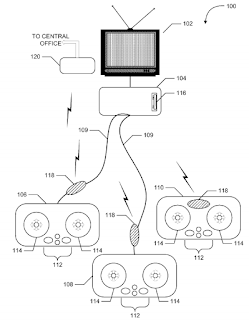U.S. Patent Not. 8,635,163: System and method for facilitating a video game exchange
Issued Jan. 21, 2014, to Green Man Gaming Limited
Summary:
The ‘163 patent relies on a network and server to allow the resale of digital downloads of games. The system retains records of which games are owned on which devices. Additionally, the system keeps track of game prices for both new and “used” versions of a game, where a “used” version is a digital download being returned for credit towards other purchases. By keeping records of what is owned by whom, the system ensures that a game that is returned for credit does not remain in a player’s inventory after resale. The system focuses exclusively on the sale and resale of games on authorized devices.
Abstract:
A system and method for facilitating the exchange of electronic video games. A video game exchange server provides interacts with a gaming device to permit a game user to buy and load a video game onto the gaming device, to play the game on the gaming device and to return the “used” game for credits that may be used to purchase a new or used game. The game exchange server assigns a price to each new game and used game in its inventory. The game exchange server also assigns a value to each game currently stored on the gaming device. The game price and the game value may decline as a function of time or based on other factors (e.g., a new release). The game exchange server also validates that a video game stored on a gaming device is authorized.
Illustrative Claim:
1. A system for exchanging video games comprising:
a network comprising a plurality of connected computers;
a video game exchange server;
a gaming device comprising a first processor in communication with the videoexchange server via the network, wherein the first processor is coupled to a memory storing executable instructions that when executed by the first processor cause the first processor to perform operations comprising:
downloading a client application from the video game exchange server;
sending, using the client application, a request to the game exchange server to establish an account for the gaming device; and
sending to the game exchange server using the client application an offer to exchange a digital game for which the gaming device has acquired use rights for a game for which gaming device has not acquired use right, wherein the offer to exchange comprises a first unique key assigned to the game offered for exchange;
wherein the video game exchange server comprises a second processor and wherein the second processor is coupled to a memory storing executable instructions that when executed by the second processor causes the second processor to perform operations comprising:
downloading a client application to the gaming device in response to the request from the client application;
establishing an account for the gaming device in response to the request from the client application;
receiving from the gaming device via the client application the offer to exchange the digital game;
confirming from the first unique key that the gaming device has acquired use rights to the digital game offered for exchange;
accepting the offer to exchange the digital game for which the use rights have been confirmed;
storing a second unique key associated with the requested game in a datastore;
retiring the first unique key of the digital game subject to the accepted offer from the datastore.











